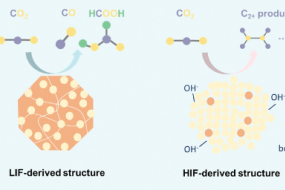Cu-based catalysts manifest a unique ability to reduce CO2 into various products such as CO, HCOOH, CH4, C2H4, and alcohols. Facet engineering is a widely used strategy to modulate the property of catalysts, which has been employed for Cu2O catalysts as well. In this work recently published in Advanced Functional Materials, we answered controversy whether the initial Cu2O facets contribute to the selectivity in electrochemical concversion CO2RR, and if not, why the Cu2O catalysts with different initial enclosed facet showed diverse performance, even though Cu2O facets are known to be unstable and can be easily transformed.
Researchers in Partcat created Cu2O microcrystals with different exposed surfaces to understand the effects of these surfaces on the catalyst's structure and the chemicals it produces during the CO2 conversion process. We found that the initial exposed surface of the Cu2O microcrystals had a direct impact on the catalyst's structural changes and the specific chemicals it produced. The low-index facet, which is more stable and requires more energy to undergo structural changes, tended to maintain its original crystalline structure and larger particle size during the transformation. This resulted in a flatter surface and limited interfaces with copper, leading to a preference for producing chemicals through a two-electron transfer process.On the other hand, the high-index facet (labeled as (311)) was more chemically active and easily underwent structural changes.
Read full article here: https://onlinelibrary.wiley.com/doi/10.1002/adfm.202210938
Meet our researcher and lead author: Jiajun Zhang

Schematic of initial exposed Cu2O facet induced diverse transformation and preferred CO2RR products.